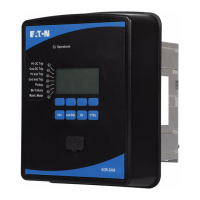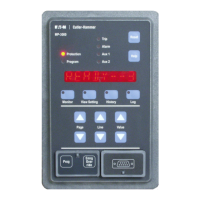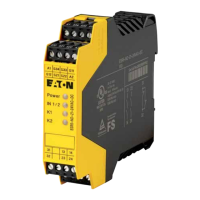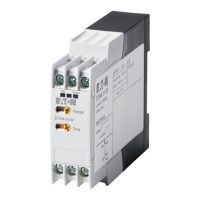DT3000 Instruction Leaflet
I.B. 17555D Effective: Date 07/02 Page 11
For more information visit: www.cutler-hammer.eaton.com
Supersedes I.B. 17555C dated November 1999
Phase Settings
Type Default Setting
Curve Shape It
I
2
T (Chicago version)
LDPU 1.0
LDT 5 seconds
40 seconds (Chicago
version)
SDPU 1.5
11 (I
n
) (Chicago version)
SDT 1.0 seconds
1.5 seconds (Chicago
version)
INST 1.75
25 (I
n
) (Chicago version)
Ground Settings
Type Default Setting
Curve Shape It
LDPU 0.5
2.0 (I
n
) (Chicago version)
LDT 5 seconds
40 seconds (Chicago
version)
SDPU 0.75
11 (I
n
) (Chicago version)
SDT 1.0 seconds
1.5 seconds (Chicago
version)
INST 1.0
11 (I
n
) (Chicago version)
Miscellaneous Settings
Type Default Setting
DISC OFF
HILD 10 seconds
FREQ 60 Hz
CT P 500
CT G 500
High Load: The available high load time-out settings are
shown in the tables above. At a current 85% or above the
inverse time overcurrent phase setting value, the high load
function will begin timing to the time setting selected and
the High Load LED will blink. If the current drops below the
85% value, the high load timer will reset, and only start
again when the 85% value is again reached. When the
High Load Timer times out three coinciding events occur:
1. The “High Load” LED on the front of the relay lights
continuously,
2. An alarm signal is sent over the communications
network, and
3. If DipSwitch #5 is in the “On” position, the high load
alarm also closes the Communications Close Relay
N.O. contacts at terminals TB2-4 and 5. These events
are reset when the current drops below the 85% level.
System Frequency Selection: Either 60Hz or 50Hz may
be selected.
Phase and Ground Ct Ratio Selection: The available Ct
ratios, shown in the above table range from 5:5 to 5000:5.
Defaults: In the unlikely event that settings are missed or
entered incorrectly, the Operational LED will blink Red and
the relay will display “PRGM” in the Settings Display
window. This means the program settings should be re-
entered and saved.
2-1.5 INTEGRAL TESTING
Digitrip 3000 Protective Relays have a front accessible,
integral field testing capability. This feature introduces a
selected level of internal test current to simulate an
overload or short circuit. It checks proper functioning of the
relay and verifies that curve settings have been set-up
correctly.
The integral test function provides selectable ‘Trip’ and ‘No
Trip’ test settings for both phase and ground testing. Refer
to the above tables for available test settings. The ‘P’ used
refer to a phase current test setting, while the ‘G’ refers to
a ground current test setting. ‘T’ in the table means that the
test will initiate a breaker trip. All settings are in per unit
current values times the I
n
value, which is the selected Ct
rating.
THE TEST MODE SHOULD NOT BE USED TO
TRIP LIVE CURRENT CARRYING CIRCUITS. IF A
LIVE CURRENT OF GREATER THAN 0.1 TIMES
THE VALUE IS FLOWING IN EITHER A PHASE OR
GROUND CIRCUIT, THE TEST MODE IS
AUTOMATICALLY EXITED, ACCOMPANIED BY AN
ERROR MESSAGE IN THE SETTINGS/TEST
TIME/TRIP CAUSE WINDOW.
2-1.6 COMMUNICATIONS
An important function of the Digitrip 3000 Protective Relay
is communications and control via the Cutler-Hammer
PowerNet Protocol. It allows the combining of electrical
distribution and control products with personal computers
into a comprehensive communications and control
network.
The Digitrip 3000’s communications chip permits the
interrogation of relay data, remote tripping and closing of
breaker, the Reset of the relay after a trip, and
downloading of set points from a remote master computer.
Note: Dip Switch #5 must be in the “Off” position to
initiate a “Communications Close” command.
Communications is accomplished from the relay to the
master computer via a 115.2 kHz frequency carrier signal
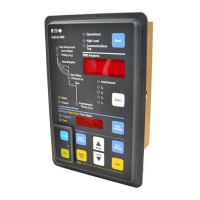
